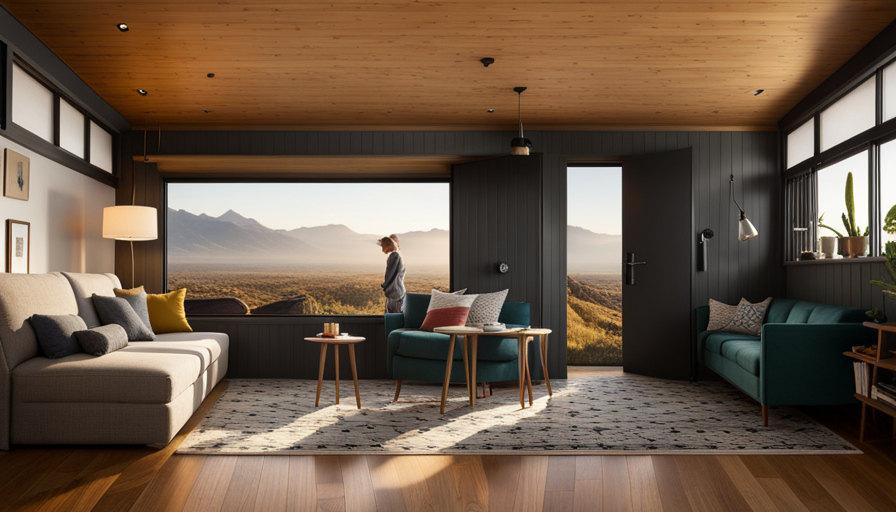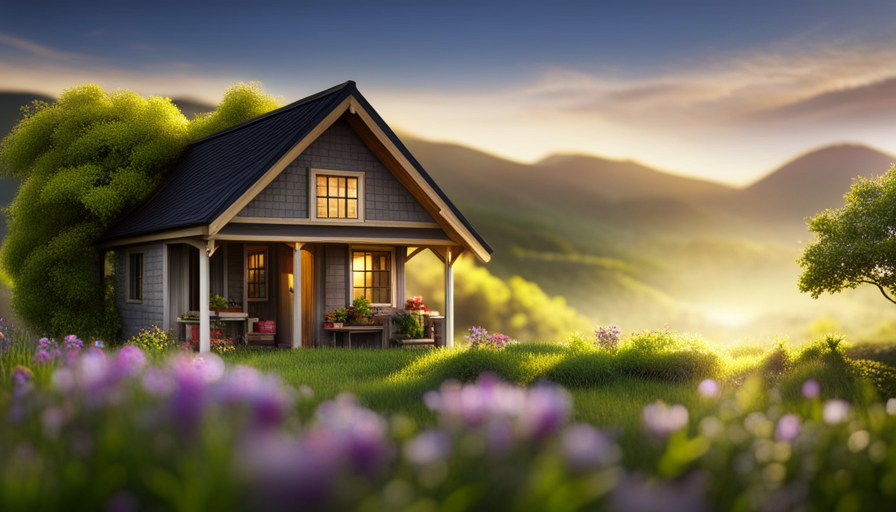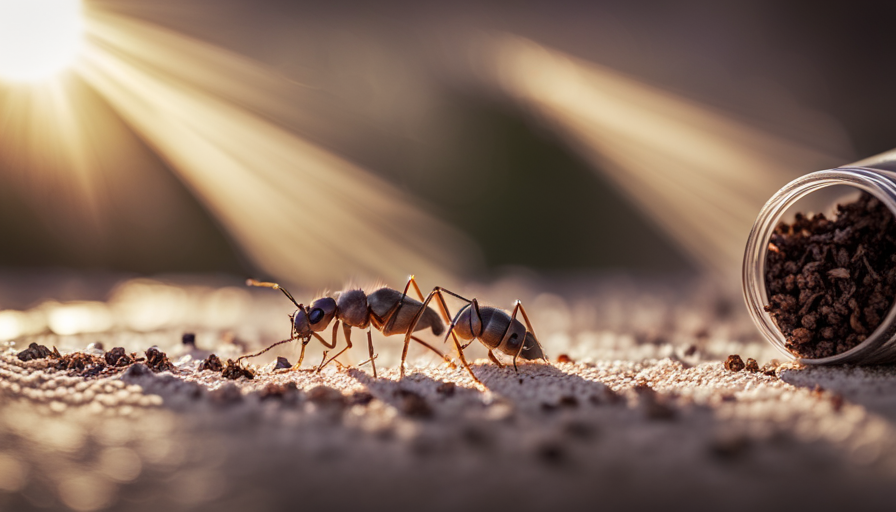Welcome to the enchanting world of tiny homes, where every square inch offers a chance for imaginative and stylish decoration. Similar to a magician creating illusions, decorating a tiny home requires a special touch to make the most of the limited space. It requires a delicate blend of functionality and visual appeal, with each decorating choice capable of transforming a small area into a breathtaking masterpiece.
In this article, I will share with you my expertise on how to decorate a tiny house, revealing the secrets to maximizing space, incorporating clever storage solutions, and adding personal touches that truly make it your own. From prioritizing multi-functional furniture to embracing minimalism, we will explore the art of creating an illusion of space while maintaining a cozy and inviting atmosphere.
So, gather your imagination and let’s embark on a journey of enchantment, where even the tiniest of spaces can be transformed into a sanctuary of style and comfort. Get ready to unlock the secrets of decorating a tiny house and unleash your inner designer.
Let’s begin!
Key Takeaways
- Embrace minimalism and regularly declutter
- Use multi-functional furniture and space-saving solutions
- Utilize light colors, natural light, and mirrors to create an illusion of space
- Personalize the tiny house with creative wall art and reflect personal style
Prioritize Multi-Functional Furniture
When decorating a tiny house, it’s crucial to prioritize multi-functional furniture. In a limited space, every piece of furniture needs to serve more than one purpose. That’s where multi-purpose furniture comes in handy.
From sofa beds that transform into a comfortable sleeping space to coffee tables with hidden storage compartments, these pieces are designed to maximize functionality while saving valuable space. When choosing furniture for a tiny house, look for items that can serve multiple purposes, such as a dining table that can also be used as a desk or a storage ottoman that doubles as extra seating.
In addition to multi-purpose furniture, space-saving solutions are also essential in a tiny house. Look for furniture that can be folded or collapsed when not in use, like collapsible dining tables or foldable chairs. Utilize vertical space by installing wall-mounted shelves or hanging organizers. These small adjustments can make a big difference in maximizing storage and creating a clutter-free environment.
Another effective technique to make a tiny house feel more spacious is to use light colors. Light-colored walls, furniture, and decor can create an illusion of space by reflecting natural light and making the room appear larger. Opt for neutral tones like whites, creams, and pastels to open up the space and create a bright, airy atmosphere.
By combining multi-functional furniture, space-saving solutions, and light colors, you can transform your tiny house into a functional and visually appealing space without feeling cramped or cluttered.
Use Light Colors to Create an Illusion of Space
To maximize the perceived size of your compact living space, opt for light colors that create the illusion of a more expansive area. Using light colors in interior design can make a significant difference in how spacious your tiny house feels. Light shades such as whites, pastels, and neutrals reflect natural light, making the room appear brighter and more open. Not only do light colors create a sense of airiness, but they also help to maximize the utilization of natural light, which is essential in small spaces.
To demonstrate the impact of light colors, let’s take a look at the following table:
| Light Color | Effect |
|---|---|
| White | Enhances brightness and openness |
| Pastels | Adds a soft and airy ambiance |
| Neutrals | Creates a versatile backdrop for other decor |
By incorporating these light colors into your tiny house, you can create a visually appealing and spacious environment. Additionally, using light colors can make it easier to incorporate multi-functional furniture that seamlessly blends into the overall design.
As we move forward, let’s explore how to maximize vertical storage options in order to make the most of your limited space.
Maximize Vertical Storage Options
If you want to live in a cramped, cluttered nightmare, don’t bother with maximizing vertical storage options. In a tiny house, every square inch matters, and utilizing vertical space is the key to creating a functional and organized living environment.
Here are some innovative ways to make the most of your vertical storage:
-
Vertical Gardening: Bring nature indoors by creating a vertical garden. Hang planters or install shelving units with space for potted plants. Not only does this add a touch of greenery to your space, but it also maximizes unused wall space.
-
Space Saving Furniture Designs: Invest in furniture pieces that are designed to save space. Look for multi-functional pieces like a bed with built-in storage or a dining table that folds down when not in use. These clever designs help you maximize storage without sacrificing style.
-
Wall-mounted Shelves: Install wall-mounted shelves to store books, decorative items, or kitchen essentials. This frees up valuable floor space and adds visual interest to your walls.
-
Overhead Storage: Utilize the space above your head by installing overhead storage racks or hanging baskets. This is a great solution for storing items that are used less frequently.
By incorporating vertical gardening and space-saving furniture designs, you can maximize storage in your tiny house and create a more spacious and organized living environment. Embrace minimalism and declutter regularly to maintain a clutter-free space.
Embrace Minimalism and Declutter Regularly
Embracing minimalism and regularly decluttering is essential for creating a spacious and organized living environment in your compact abode. By adopting a minimalist mindset, you can prioritize the items that truly add value to your life and let go of unnecessary clutter.
Utilize small spaces efficiently by investing in multifunctional furniture pieces that offer both storage and functionality. Opt for beds with built-in drawers or ottomans that can store extra blankets or pillows. Embrace minimalism by keeping surfaces clear and only displaying a few carefully chosen decorative pieces. Utilize vertical storage options, such as wall-mounted shelves or hanging organizers, to maximize the use of space.
Regularly decluttering is crucial in maintaining a tidy and airy atmosphere. Set aside time each month to assess your belongings and donate or sell items that no longer serve a purpose. By keeping your possessions to a minimum, you create a sense of tranquility and openness in your tiny house.
Now, let’s explore how you can let in natural light with large windows and skylights, enhancing the overall ambiance of your petite dwelling.
Let in Natural Light with Large Windows and Skylights
Maximizing the use of natural light through the installation of large windows and skylights can create an airy and inviting atmosphere in your compact living space. Skylight installation is a fantastic way to bring in additional natural light and brighten up your tiny house.
Not only does natural light make a space feel more open and spacious, but it also has numerous benefits for our well-being. Natural light has been proven to boost mood, improve productivity, and enhance our overall health.
By incorporating large windows and skylights into your tiny house design, you can let in an abundance of natural light during the day. This will eliminate the need for artificial lighting and save on energy costs. The natural light will make your space feel warm and cozy, while also providing a connection to the outdoors.
In addition to the practical benefits, the aesthetic appeal of natural light cannot be overlooked. It adds a sense of beauty and tranquility to your living space. The sunlight streaming in through the windows and skylights creates a play of light and shadow, giving your tiny house a unique and artistic ambiance.
To further enhance the illusion of a larger space, utilize mirrors strategically throughout your tiny house. Mirrors reflect light and create the illusion of depth, making your space appear larger than it actually is. Incorporating mirrors into your décor will complement the natural light and maximize the sense of openness in your compact living space.
Utilize Mirrors to Create the Illusion of a Larger Space
Enhance the feeling of spaciousness in your compact living space by strategically placing mirrors throughout, creating the illusion of a larger area. Mirrors are an essential element in decorating a tiny house as they have the power to transform a small space into something much bigger and brighter.
Here are four clever ways to incorporate mirrors into your tiny house design:
-
Opt for floor-to-ceiling mirrors: By installing large mirrors from floor to ceiling, you can visually expand the height of the room, giving it a more open and airy feel.
-
Hang mirrors opposite windows: Placing mirrors directly across from windows allows them to reflect natural light, amplifying it throughout the space. This not only brightens up the room but also creates the illusion of a larger area.
-
Use mirrored furniture: Incorporating mirrored furniture, such as a coffee table or sideboard, adds a touch of elegance while reflecting light and making the room appear more spacious.
-
Create a mirror gallery wall: Grouping smaller mirrors together on a wall can create a stunning focal point and make the room feel larger by bouncing light around the space.
By incorporating clever lighting techniques and using reflective surfaces like mirrors, you can maximize the illusion of space in your tiny house. Now, let’s explore how to incorporate clever storage solutions, such as under-stair storage or built-in shelves, to optimize the functionality of your compact living area.
Incorporate Clever Storage Solutions, such as Under-Stair Storage or Built-In Shelves
By incorporating under-stair storage or built-in shelves, you can cleverly optimize the functionality of your compact living area and create a clutter-free space.
One of the biggest challenges in a tiny house is finding enough storage solutions to keep all your belongings organized. That’s where under-stair storage comes in handy. Utilizing the space underneath your staircase not only maximizes storage potential but also adds a unique touch to your interior design. You can install drawers, cabinets, or even create a cozy reading nook under the stairs. It’s a versatile and efficient way to make the most out of every inch of your tiny home.
Built-in shelves are another fantastic option for storage in a small space. They can be installed on walls, above doorways, or even built into furniture pieces like desks or bed frames. These shelves provide a stylish and functional solution for displaying your favorite books, photos, or decorative items. Additionally, they free up valuable floor space and make your tiny house feel more open and airy.
To further maximize storage potential, consider under bed storage and creative wall hooks. Under bed storage containers or drawers are perfect for stashing away items that you don’t use frequently, such as seasonal clothing or extra bedding. Creative wall hooks can be used to hang coats, hats, bags, or even kitchen utensils, freeing up drawer and cabinet space.
With clever storage solutions like under-stair storage, built-in shelves, under bed storage, and creative wall hooks, you can transform your tiny house into a well-organized and functional living space. Now, let’s move on to the next step and explore how to create zones and define spaces with area rugs or room dividers.
Create Zones and Define Spaces with Area Rugs or Room Dividers
Transform your living space into a cozy and inviting oasis by creating distinct zones and defining spaces using area rugs or room dividers.
One of the most effective ways to create zones in a tiny house is by using area rugs. They not only add warmth and texture to the space but also visually separate different areas. Place a rug under your dining table to define the eating area, or use a larger rug to designate a seating area in your living room.
Another creative way to define spaces is by using room dividers. Instead of traditional dividers, consider incorporating plants into your design. Large potted plants can act as natural dividers, adding a touch of greenery while also creating a sense of privacy. If you prefer a more flexible option, sliding doors can be a great alternative. They can be opened or closed as needed, allowing you to easily transform your space to meet your changing needs.
By creating distinct zones and defining spaces with area rugs or room dividers, you can maximize the functionality of your tiny house while also giving it a stylish and cohesive look.
Now, let’s move on to the next section and learn how to choose furniture and decor that is proportional to the space.
Choose Furniture and Decor that is Proportional to the Space
To create a visually balanced and harmonious living environment, it’s crucial to select furniture and decor that perfectly fits the size and layout of your small space. When it comes to furniture arrangement in a tiny house, it’s all about maximizing space and utilizing clever space-saving strategies.
One important consideration is to choose furniture that is proportional to the size of your space. Oversized furniture can make a small room feel cramped and overwhelming, while furniture that is too small can make the space feel empty and incomplete. Finding the right balance is key.
To help you visualize the impact of furniture proportion in a tiny house, here is a handy table that shows different furniture sizes and their recommended dimensions for a small space:
| Furniture Item | Recommended Dimensions |
|---|---|
| Sofa | 60-72 inches wide |
| Dining Table | 36-48 inches diameter |
| Bed | Twin or Full size |
| Coffee Table | 24-36 inches diameter |
| Desk | 30-40 inches wide |
| Chairs | 18-24 inches wide |
By choosing furniture that fits within these dimensions, you can create a more visually appealing and functional space. Once you have the right furniture, you can then move on to personalizing your tiny house with creative and functional decor pieces.
Personalize Your Tiny House with Creative and Functional Decor Pieces
As we continue our journey on how to decorate a tiny house, we now move on to the exciting task of personalizing your space with creative and functional decor pieces. While choosing furniture and decor that’s proportional to the space is essential, it’s equally important to infuse your own personality and style into your tiny house.
One way to do this is by incorporating creative wall art. Think outside the box and opt for unique and eye-catching pieces that reflect your interests and passions. Whether it’s a gallery wall of family photos, a collection of vintage posters, or even your own artwork, the possibilities are endless. Not only will this add visual interest to your space, but it’ll also make it feel like a true reflection of your personality.
Another way to personalize your tiny house is by selecting unique lighting fixtures. Instead of sticking to standard, generic options, consider choosing fixtures that are both functional and artistic. Pendant lights, string lights, or even repurposed items can add a touch of whimsy and uniqueness to your space.
By incorporating creative wall art and unique lighting fixtures, you can truly make your tiny house feel like a one-of-a-kind home that reflects your individual style and taste.
Frequently Asked Questions
How can I make the most of the vertical space in my tiny house?
To maximize storage in my tiny house, I focus on utilizing vertical shelving. I imagine my walls as a blank canvas waiting to be transformed into functional art. With a touch of creativity, I install floating shelves and wall-mounted organizers that not only save floor space but also add a unique aesthetic to my home.
From stylish bookshelves to hanging baskets, the possibilities are endless when it comes to using every inch of vertical space.
What are some clever storage solutions that I can incorporate into my tiny house?
When it comes to clever storage solutions and maximizing space in a tiny house, there are countless options to consider. From utilizing under-bed storage and wall-mounted shelves to installing built-in cabinets and multi-functional furniture, the possibilities are endless.
Think outside the box and look for innovative ways to create hidden storage compartments and utilize every nook and cranny. With some creativity and careful planning, you can transform your tiny house into a functional and organized living space.
How can I create different zones and define spaces in my tiny house?
In my tiny house, I’ve discovered the key to creating separate areas and defining spaces is through clever furniture choices. Multi-functional furniture is a game-changer.
For example, a sleek bookshelf can act as a room divider, separating the living area from the bedroom. A foldable dining table can transform into a workspace when needed. By strategically placing these pieces, I’ve managed to establish distinct zones that make my tiny house feel spacious and functional.
What are some tips for choosing furniture and decor that is proportional to a small space?
When it comes to choosing furniture and decor for small spaces, it’s all about maximizing functionality and style.
One key tip is to opt for multi-purpose pieces that serve more than one function. For example, a coffee table with built-in storage or a sofa that can be converted into a bed.
Additionally, consider the proportions of the furniture and decor to ensure they don’t overpower the space. Stick to sleek and compact designs that won’t overcrowd the room, but still make a statement.
How can I personalize my tiny house with creative and functional decor pieces?
To personalize my tiny house with creative and functional decor pieces, I explore unique space-saving storage ideas. I utilize vertical space with floating shelves and wall-mounted organizers to maximize storage without sacrificing style. Additionally, I love incorporating DIY projects into my decor. I enjoy hand-painting accent walls and repurposing furniture to add character and charm to my tiny space. By combining functionality and creativity, I create a home that’s uniquely mine.
Conclusion
In conclusion, decorating a tiny house is all about making the most of limited space without sacrificing style and functionality. By prioritizing multi-functional furniture and using light colors, you can create a visually appealing and efficient living space.
Maximizing vertical storage options and embracing minimalism are also important factors in tiny house decor. Incorporating clever storage solutions, defining spaces with area rugs or room dividers, and choosing furniture and decor that is proportional to the space will further enhance the overall design.
So go ahead and let your creativity shine as you personalize your tiny house with unique and functional decor pieces, turning it into a captivating work of art that maximizes every inch of space available. Just like a master painter meticulously brushes strokes of color onto a canvas, you can transform your tiny house into a masterpiece that showcases your individual style and personality.
Hi, I’m Emma. I’m the Editor in Chief of Tiny House 43, a blog all about tiny houses. While tree houses are often associated with childhood, they can be the perfect adult retreat. They offer a cozy space to relax and unwind, surrounded by nature. And since they’re typically built on stilts or raised platforms, they offer stunning views that traditional homes simply can’t match. If you’re looking for a unique and romantic getaway, a tree house tiny house might just be the perfect option.










